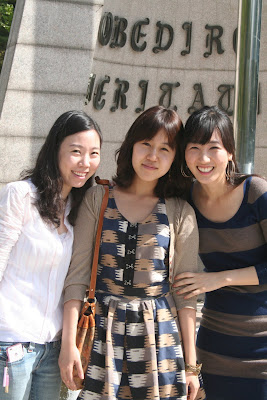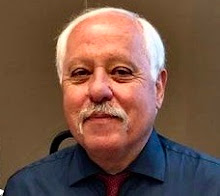 Despite a somewhat rocky start, I had a great experience during my two weeks in Seoul, South Korea.
Despite a somewhat rocky start, I had a great experience during my two weeks in Seoul, South Korea.Initially intimidated by the sheer welter of humanity in Seoul, I vanished into my hotel room, suffering from jet lag for the first 24 hours. Once I recovered and got the hang of the place, I was fine.
 Spent four days with my daughter Gina, who is teaching English in Busan, a city located on the opposite side of South Korea. Busan is about 150 miles from Seoul, so Gina took the two-hour ride on the high-speed "bullet train" to Seoul.
Spent four days with my daughter Gina, who is teaching English in Busan, a city located on the opposite side of South Korea. Busan is about 150 miles from Seoul, so Gina took the two-hour ride on the high-speed "bullet train" to Seoul.Enjoyed dinner with recent UO School of Journalism and Communication graduates Branden Johnson and Bryan Saxton. Both are also teaching English in South Korea.
My lecture on healthcare public relations to a class of about 80 aspiring Korean public relations students at Sogang University went very well. As previously noted in these pages, the students were polite, attentive and inquisitive, with excellent questions.
Many thanks to my friend and colleague Dr. Kyu Ho Youm for helping arrange the opportunity.
Here are a few quick impressions of Korea:
The Korean people -- a delightful and attractive lot -- are wonderful, but the contradictions are readily apparent: traditional yet modern, reserved yet aggressive. Their voices are soft but their horns are loud. They even have a cold soup that's hot (spicy).
 Speaking of food, Korean grub is -- by and large -- delicious. I personally don't like kim chee (a Korean favorite), mostly because it's basically cabbage, but many others do. But watch out for "American food" in Korea. It might look American, but it's not even close.
Speaking of food, Korean grub is -- by and large -- delicious. I personally don't like kim chee (a Korean favorite), mostly because it's basically cabbage, but many others do. But watch out for "American food" in Korea. It might look American, but it's not even close.Deluxe (black cabs) taxi drivers are slow, scheming, expensive and devious. They take their sweet time to get you where you need to go so they can receive a larger fare.
Economy (grey cabs) taxi drivers are wild and crazy -- moving briskly while weaving through traffic. But they get you where you need to be safely -- with more personality for a lot less won.
 The air in Seoul was generally smoggy, at least in September. Compares with L.A. In the spring, the city is clouded with a yellow dust from the deserts of China. Most of the time, you can smell the sewers, much like in downtown Philadelphia.
The air in Seoul was generally smoggy, at least in September. Compares with L.A. In the spring, the city is clouded with a yellow dust from the deserts of China. Most of the time, you can smell the sewers, much like in downtown Philadelphia.The numerous unique bridges over the Han River are beautifully designed. Of the Westerners I saw in Korea, most are pukes who won't even look you in the eye. Not sure why.
Koreans are consistent in at least one way. Many carry their umbrellas no matter what the weather -- to protect themselves from the rain or the hot sun.













































